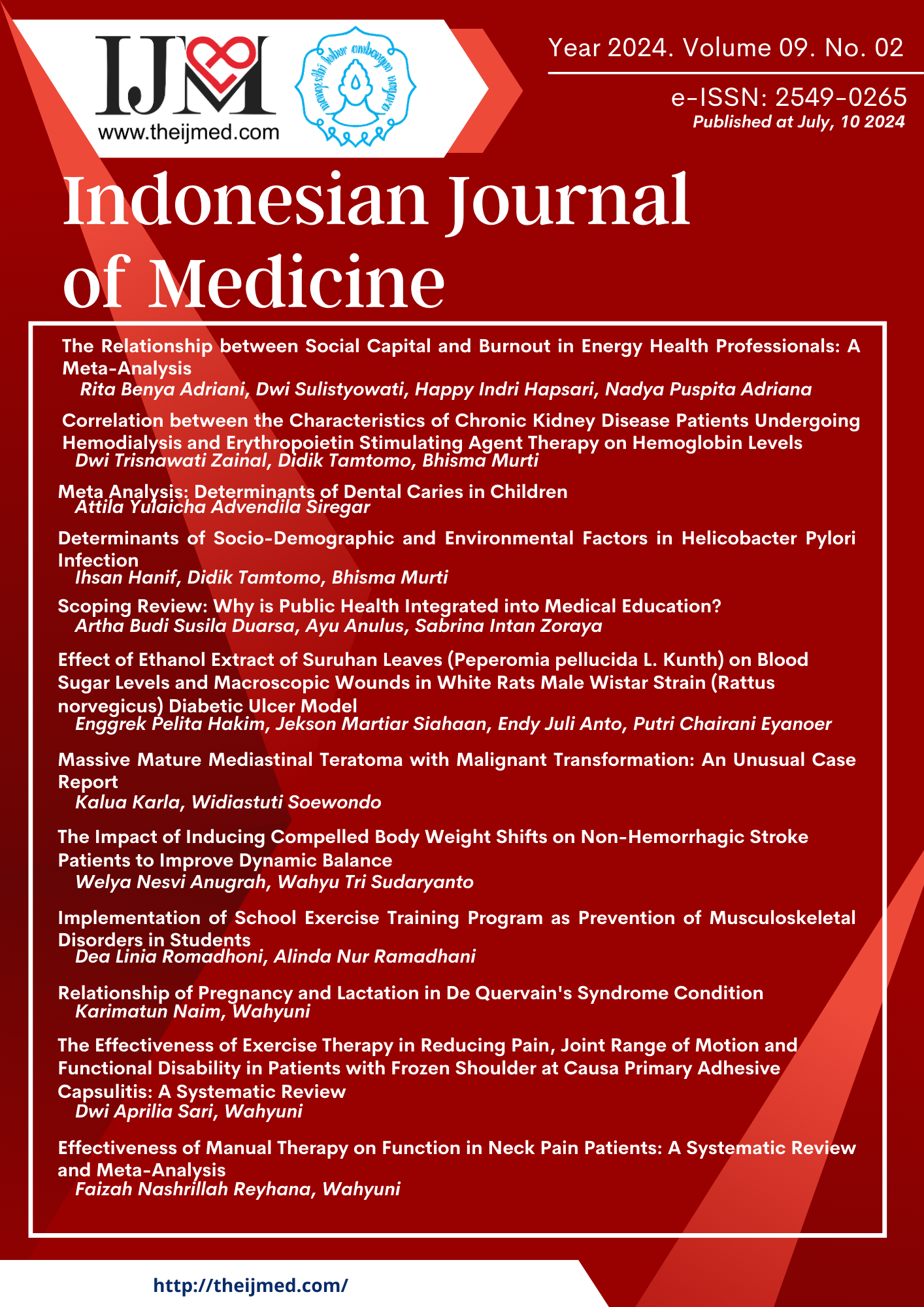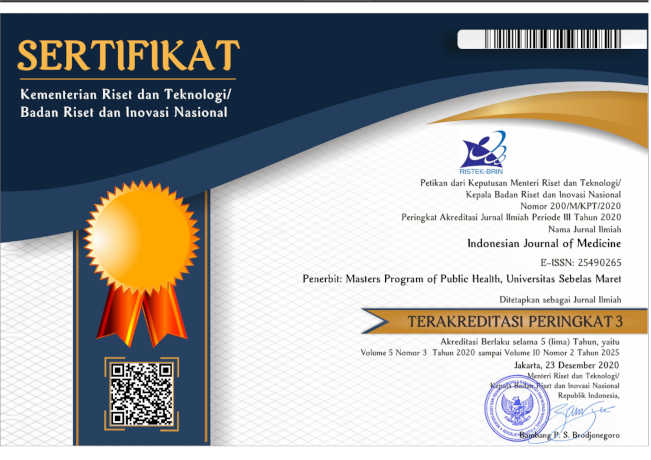Application of the Health Belief Model for Assessing Risk Behavior among Patients Experiencing Musculoskeletal Pain Treated with Acupuncture in Surakarta
DOI:
https://doi.org/10.26911/theijmed.2024.9.2.752Abstract
Background: Musculoskeletal pain is a complaint that occurs in parts of the skeletal muscles which is felt by a person ranging from mild complaints to very painful. This study aimed to analyze the effects of perceived vulnerability, perceived benefits, perceived barriers, and self-efficacy on risky behavior in patients complaining of musculoskeletal pain treated with acupuncture.
Subjects and Method: This was a cross-sectional study conducted in Surakarta, from November-December 2023. A total of 200 patients were selected using fixed disease sampling. The dependent variable was risk behavior for musculoskeletal pain. The independent variables were perceived vulnerability, perceived vulnerability, perceived benefits, perceived barriers, cues to action, and self-efficacy. The data were analyzed using a multiple linear regression.
Results: Musculoskeletal pain risk behaviors (MSDs) decreased with increasing perceived susceptibility (b= -0.22; 95% CI= -0.29 to -0.16; p<0.001), perceived benefit (b= -0.09; 95% CI= -0.13 to -0.05; p<0.001), and self-efficacy (b= -0.06; 95% CI= -0.11 to -0.01; p=0.015) and increased with increasing perceived barriers (b= 0.05; 95% CI= 0.02 to 0.09; p= 0.002).
Conclusion: Perceived vulnerability, perceived benefits, and self-efficacy decrease risk behavior in musculoskeletal pain patients, and perceived barriers increase risk behavior in musculoskeletal patients.
Keywords:
Health belief model, musculoskeletal pain, acupunctureReferences
Al‐Metwali B, Al‐Jumaili A, Al‐Alag Z, Sorofman B (2021). Exploring the acceptance of COVID‐19 vaccine among healthcare workers and general population using health belief model. J Eval Clin Pract, 27(5), 1112-1122. DOI : 10.1111/jep.13581
Bahrudin M (2017). Patofisiologi nyeri (Pathophysiology of pain). Medika Saintika, 13(1). DOI : 10.22219/sm.v13i1.5449
Block LG, Keller PA (1997). Effects of Self‐Efficacy and Vividness on the Persuasiveness of Health Communi-cations. J Consum Psychol Rev. 6(1): 31–54. DOI : 10.1207/s15327663jcp-0601_02
Caneiro J, Bunzli S, O'Sullivan P (2021). Beliefs about the body and pain: the critical role in musculoskeletal pain management. Braz J Phys Ther, 25(1):17-29. DOI : 10.1016/j.bjpt.20-20.06.003
Jaya B & Mitoriana Porusia S. K. M. (2023). Faktor-faktor Yang Berhubungan Kejadian Musculoskeletal Disorder Pada Pengemudi Bus Batik Solo Trans Kota Surakarta (Factors Associated with the Incident of Musculoskeletal Disorder in Batik Solo Trans City Surakarta Bus Drivers) (Doctoral dissertation, Universitas Muhammadiyah Surakarta).
Kim S, Nussbaum MA, Smets M, Ranganathan S (2021). Effects of an arm‐support exoskeleton on perc-eived work intensity and musculo-skeletal discomfort: An 18‐month field study in automotive assembly. Am J Ind Med. 64(11): 905–914. DOI : 10.1002/ajim.23282
Ogunrinde O, Nnaji C, Amirkhanian A (2021). Quality Management Techno-logies in Highway Construction: Stakeholders’ Perception of Utility, Benefits, and Barriers. Pract Period Struct Des. 26(1): DOI : 10.1061/-(ASCE)SC.19435576.0000531
Ryu T, Kwon S, Jee SC, Oh MD, Yun MH (2014). Relationships of musculo-skeletal disorder symptoms and perceived workload among hospital workers. Bridging Research and Good Practices towards Patients Welfare: Proceedings of the 4th International Conference on Healthcare Ergonomics and Patient Safety (HEPS), Taipei, Taiwan, 23-26 June 2014, 155.
Srinivasa N, Daniel B, Miltonc C, Nanna B, Hertaf F, Stepheng G, Francis J, et al. (2020). The revised International Association for the Study of Pain definition of pain: concepts, challenges, and compromises. PAIN. 161(9): 1976-1982. DOI: 10.1097/j.-pain.0000000000001939
Sudirman A, Paneo I, Pulubuhu H (2023). Asuhan keperawatan keluarga dalam meningkatkan kemdanirian keluarga dengan penerapan health belief model di Desa Mongolato (Family nursing care in increasing family independence by implementing the health belief model in Mongolato Village). Berkala Ilmiah Mahasiswa Ilmu Keperawatan Indonesia, 11(1): 24–31. DOI : 10.53345/bimiki.v11i1.395
Weale V, Stuckey R, Kinsman N, Oakman J (2022). Workplace musculoskeletal disorders: A systematic review and key stakeholder interviews on the use of comprehensive risk management approaches. Int J Ind Ergon. 91: 103-338. DOI : 10.1016/j.ergon.2022.10-3338.











